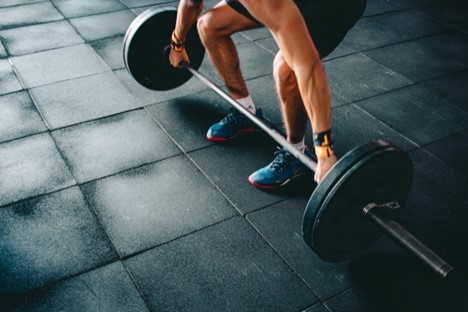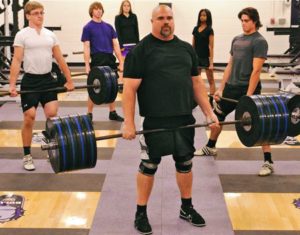 An interview with Bryan Neese
An interview with Bryan Neese
Some of the photography in this feature was shot exclusively for Faith & Fitness Magazine by Mark Lee of Great Exposures. Copyright 2014 Great Exposures and Lifestyle Media Group.
Faith & Fitness Magazine: Bryan, you’ve done just a little bit of power lifting in your day. Define what it is and share what all you’ve done.
Bryan Neese: Power Lifting competition and training is based around three basic lifts: the back squat, bench press and deadlift. Power lifters train all three and do assistance work on a nine or twelve week cycle. The culminating activity will be a 1-repetition max lift for each of the three lifts. In a full meet all three lifts are done in order: squat first, bench second and finally the deadlift. We have a saying that the meet is never over until the last deadlift hits the floor. The deadlift can make or break your total in a power lifting meet.
I’ve been lifting for more than thirty-four years since I was sixteen. I’ve been blessed to win the Indiana Drug Free power lifting championship for the 319 pound class, the deadlift championship and the bench press championship. That led to me winning multiple highland games amateur championships. In 1999 I won the United States World’s Strongest Man contest. After that win I competed in the Worlds Strongest Man contest and I went on to have a five-year career in professional strength athletics. In 2012 I added Olympic lifting and won the Masters Midwest Open in the 205+Kg division. Recently I placed sixth in the Masters Americas Strongest Man contest.
Every strongman competition for me includes a deadlift. It may be a regular barbell deadlift or deadlifting things like train wheels, oxygen tanks or even cars and trucks. None of my post competitive power lifting success would have been possible without a huge amount of regular power lifting work especially the deadlift. Right now I deadlift twice per week as part of my workout program.
Faith & Fitness Magazine: How is power lifting different from regular strength training and bodybuilding? What risks are there? What unique benefits do you get from it physically, mentally and spiritually?
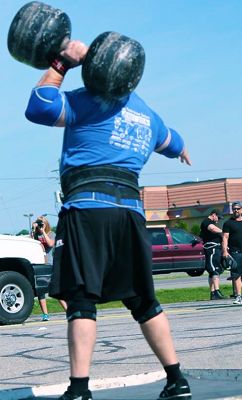 Bryan Neese: In power lifting you tend to do less reps then you would if you were lifting for fitness or bodybuilding (one to five rep range). The goal of the power lifter is to lift the most weight possible. To do this he or she must strengthen the tendons and increase the muscle strength without regard to building large muscles or great fitness. Good power lifters do a lot of additional work beyond deadlifts, bench press and back squats to strengthen the tendons and keep joints healthy especially when they’re being put under stress with heavy weights.
Bryan Neese: In power lifting you tend to do less reps then you would if you were lifting for fitness or bodybuilding (one to five rep range). The goal of the power lifter is to lift the most weight possible. To do this he or she must strengthen the tendons and increase the muscle strength without regard to building large muscles or great fitness. Good power lifters do a lot of additional work beyond deadlifts, bench press and back squats to strengthen the tendons and keep joints healthy especially when they’re being put under stress with heavy weights.
A fitness athlete is not as interested in raw strength or large muscles as a power lifter or bodybuilder. Fitness athletes work to increase cardio vascular fitness and muscular endurance. Cross Fitters are great examples of functional fitness training. In bodybuilding the athlete uses a lot higher rep scheme (8-12) and higher number of sets to cause muscular hypertrophy. Many body builders are strong but strength is not their primary emphasis. They want large, well defined muscles.
If you train with perfect form, stay in the correct biomechanical grove for all lifts, and do not stress injured areas then you have minimal risk of injury while doing the primary power lifts. Injury is possible in any physical activity if it is being performed improperly or in a careless manner. There is not an increased incident of injury in power lifters versus fitness athletes or body builders.
Physically I have to have power in my job as a strength coach to demonstrate proper form and have credibility among my high school athletes. I can’t imagine not working out and working out heavy. I was in the hospital a few year ago for a bad infection. The day after I left the hospital, even though I had a pick line in my arm, I was back in the gym using a safety bar to do back squats. My wife wasn’t happy but when I train hard and heavy I just feel so much better mentally and physically.
One positive spiritual aspect of my training is that I am very focused. This helps me stay faithful in reading my Bible daily. I am very regimented in how I train. Likewise, I always keep Sunday worship and Bible reading as part of what I regularly do.
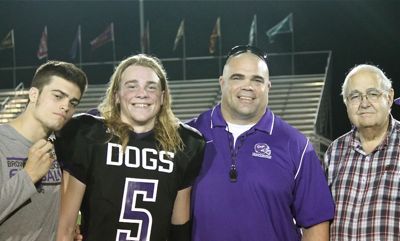 Faith & Fitness Magazine: Your background in fitness and power lifting ultimately shaped the way you raised your sons. Your oldest son Steel works at the local high school where you’re both on staff. Share what those early years were like and describe what it’s like to have your son work alongside you.
Faith & Fitness Magazine: Your background in fitness and power lifting ultimately shaped the way you raised your sons. Your oldest son Steel works at the local high school where you’re both on staff. Share what those early years were like and describe what it’s like to have your son work alongside you.
Bryan Neese: I would not have wanted to be my sons when they were young. Every one kept asking them, “Are you going to be a strongman like your dad?” When they played sports like football people who were upset that they were playing ahead of their kid asserted it was because I was the high school strength coach. I had nothing to do with the day-to-day coaching of football. I had no more influence than any other parent but both of my boys had to endure that. Fortunately they have a great mom, my wife Erica. She has always helped the boys and me keep most of the negative stuff at bay.
One great thing that came out of that is that we spend hours together in the weight room training. My boys really like the positive influence of lifting. My daughter Becca wants nothing to do with athletics. That’s fine with me because we connect in other ways. The boys were both involved in power lifting and Olympic lifting. They won or placed high in national competitions. Steele still competes in Olympic lifting. Stone is currently in college on a wrestling scholarship.
 Steele is an assistant wrestling coach at the high school. He also works as a personal trainer and does athletic development work with elementary and middle school athletes at a private facility. It’s great having him work with both high school and the younger kids. II know they are being taught proper technique. He has tremendous patience with beginning athletes.
Steele is an assistant wrestling coach at the high school. He also works as a personal trainer and does athletic development work with elementary and middle school athletes at a private facility. It’s great having him work with both high school and the younger kids. II know they are being taught proper technique. He has tremendous patience with beginning athletes.
Faith & Fitness Magazine: Being a strength and conditioning coach at a school with a highly ranked athletic program is demanding. What do you do? How do you help parents and youth find balance between their own performance expectations and the bigger picture life values? Beyond games won or new records achieved what are the strengths you want to equip them to have?
Bryan Neese: My day starts in the weight room at 5:20am and ends around 6:00pm five or six days a week depending on the season. I don’t get a break in the summer. I go from twelve-hour days to nine-hour days. I put pressure on myself to get our athletes in the best possible shape. It bothers me if we lose a contest because the opposing team is physically better. Genetics and parents are strong factors in an athlete’s success. Beyond that I want to do my best to give my guys and gals the greatest competitive advantage.
I work with around 350 athletes daily. Based on projected school growth that number will increase to about 500 athletes. Everyone has an individual workout that they must follow consisting of the Olympic lifts and the basic power lifts. Every week we clean, front and back squat, deadlift, bench, and do neck work. We also do additional exercises to strengthen assistance muscles and reduce the risk of muscle injury from competition or practice.
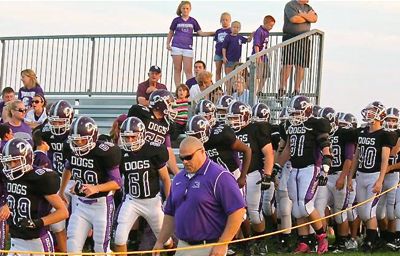 I stress to the parents and the students that as athletes they need to learn discipline in life and the concept of always giving everything you have to achieve your goals. Too often parents and teens think the world owes them something. TV commercials tell us we deserve so much. Government give away programs fuel that more.
I stress to the parents and the students that as athletes they need to learn discipline in life and the concept of always giving everything you have to achieve your goals. Too often parents and teens think the world owes them something. TV commercials tell us we deserve so much. Government give away programs fuel that more.
The only thing we really deserve is hell. Thanks to Jesus Christ we have been spared from that fate by his death on the cross and his resurrection.
The world owes us nothing. When we learn to work hard and have discipline we can achieve goals and live a life that is pleasing to God. I share with our football team about the value of doing everything we can. At the end of the day, regardless if we win or lose, we can have confidence we did everything to prepare for the game. Beyond sports, if we take that same attitude and work ethic into life we’ll be successful.
 Faith & Fitness Magazine: How do you feel those students, parents and faculty/staff/professionals who are Christian should live their faith fully without compromise and at the same time demonstrate compassion without being offensive?
Faith & Fitness Magazine: How do you feel those students, parents and faculty/staff/professionals who are Christian should live their faith fully without compromise and at the same time demonstrate compassion without being offensive?
Bryan Neese: I wrestle with this like everyone does. I believe if you really treat everyone with the love of Christ and give them respect, then they will notice that you’re different and want to know what you have that they don’t. Then you can really share Christ and be a positive witness.
Fortunately for me, God is forgiving. I often fail to fully demonstrate the love of Christ toward my students. Young men and women can often be frustrating and I catch myself being less than a strong Christian witness. My job is to help youth push their bodies and minds beyond their comfort zone and make physical gains to be successful in the largest sports environment in the state. Indiana is divided into six different classes based on school size. With over 2400 students we are in the largest class competing with schools that often have 4000 to 5000 students.
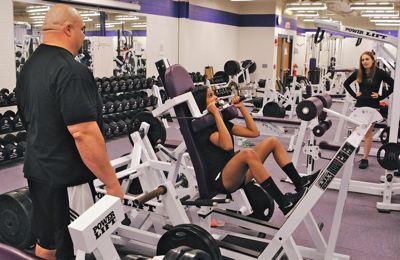 We all, myself included, need to continually be on guard against the evil one and model Christ in what we do daily. That doesn’t mean we hit others over the head with the Bible, rather we let our yes be yes and our no be no.
We all, myself included, need to continually be on guard against the evil one and model Christ in what we do daily. That doesn’t mean we hit others over the head with the Bible, rather we let our yes be yes and our no be no.
Faith & Fitness Magazine: Share about your personal faith in God and how that shapes who you are. What does it mean to you, to BE LIFE?
Bryan Neese: I could not go one day without Jesus. If you have a friend and you never communicate with him it is hard to stay friends. So I make sure I pray daily and read my Bible. The world and pressures of the job crash down on me without that daily interaction. I’m a competitive guy in a testosterone-filled environment. My relationship with my Lord acts as the buffer that keeps me in line. My faith keeps me balanced. Without God I am not sure how you could have hope.
To BE LIFE means to work hard at living out my Christian walk daily. When I fail I have forgiveness through Christ and God sets me back on the right path.
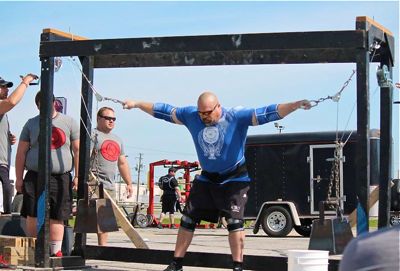 Faith & Fitness Magazine: I understand that you have personally contributed to the Paul Anderson Youth Home, which we feature in the magazine. How did Paul Anderson inspire you and what makes his youth home a ministry you support?
Faith & Fitness Magazine: I understand that you have personally contributed to the Paul Anderson Youth Home, which we feature in the magazine. How did Paul Anderson inspire you and what makes his youth home a ministry you support?
Bryan Neese: When I was part of the Mighty Warriors Power Ministry all of the money we raised went to the youth home. Paul Anderson was an amazing man of God. His life story is incredible and is detailed in the book, Paul Anderson the Mightiest Minister. He began as a sickly young man. He went on to win an Olympic Gold medal and then used his strength for the rest of life to serve God by helping others.
It was my honor to duplicate many of the same displays of strength he did. For example, I got to recreate his famous table lift with boys from the youth home when they placed a memorial in his honor during the Atlanta Olympics. His wife Glenda still runs the home. She is an awesome woman of God. His life has always been an inspiration to me. I’ve been blessed to visit the home several times. I’m always amazed how God uses their staff to shape young men’s lives.
 Faith & Fitness Magazine: What are the biggest challenges facing youth these days? What are their areas of greatest opportunity? You’re specifically tasked with the job of helping them to grow stronger physically. What can be done to help them grow stronger in character and in forming their own personal faith?
Faith & Fitness Magazine: What are the biggest challenges facing youth these days? What are their areas of greatest opportunity? You’re specifically tasked with the job of helping them to grow stronger physically. What can be done to help them grow stronger in character and in forming their own personal faith?
Bryan Neese: When I was their age we had three basic television channels, the wall-mounted phone in the kitchen was limited to mostly local free calls, information came primarily from books, movies were mostly rated G and PG and you could play outside beyond dark without worrying about safety.
Today’s climate is very different. Youth have hundreds of TV channels streaming negative images 24/7. They just reach in their pocket to call virtually anywhere in the US or the world on impulse. They instantly access information both positive and negative on that same phone or computer. It’s increasingly rare to find G rated movies, so they’re seeing sex, violence and a self-serving “give me more” attitude at an early age. Moreover, it is becoming increasingly difficult for them to go outside unsupervised during the day let alone at dark because someone may hurt them or sell them drugs. Those are major challenges for youth in an aggressively hostile world context that says, “Do whatever you want to do as long as it feels good to you.”
However, amidst those negatives there’s a greater opportunity to do good things. Even though social media can be used to spread evil it can be used like Faith & Fitness Magazine to spread family values and the good news of Jesus Christ. Career opportunities are greater now for young people than they were thirty years ago for me. When I graduated college my passion for strength training led primarily to opening a commercial gym. Strength coaches didn’t exist then and there weren’t opportunities to get educated to become one. Now, at least one of my student athletes graduate each year and go into the profession via college or by certification courses.
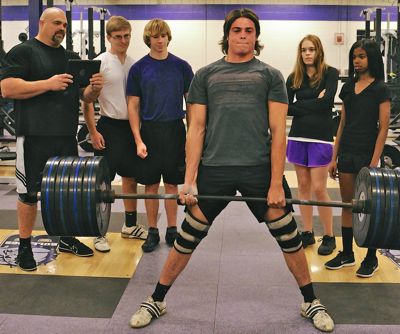 If we really want young people to grow stronger in character and spirit we have to model daily those thing that we know will help them in their faith and future. More is caught then taught. We can’t say one thing and do another. We can’t expect them to do as we say not as we do. I believe in a strong work ethic. I haven’t missed a day of work now for at least four years. The kids know and respect that. It gives me a great opportunity to talk with them about being faithful and working hard to achieve your goals. We can’t tell kids to go to church [and pursue wholesome fellowship] if we don’t go.
If we really want young people to grow stronger in character and spirit we have to model daily those thing that we know will help them in their faith and future. More is caught then taught. We can’t say one thing and do another. We can’t expect them to do as we say not as we do. I believe in a strong work ethic. I haven’t missed a day of work now for at least four years. The kids know and respect that. It gives me a great opportunity to talk with them about being faithful and working hard to achieve your goals. We can’t tell kids to go to church [and pursue wholesome fellowship] if we don’t go.
Nobody is perfect. More than most people, my student athletes know I mess up. They also know I am forgiven and pursue God’s power to correct my mistakes. I have to model Christ daily and be available to lift their spirit when they need to talk. To someone who is struggling, a kind word and positive feedback can make a huge difference.
Bryan Neese, his son Steele and a few of Bryan’s students demonstrate the deadlift for the October/November 2014 cover of Faith & Fitness Magazine.
Bryan Neese, NASM CES, USAW Senior Coach, USAW Sport Performance Coach, CSCC, is the Director of Athletic Development at Brownsburg High School in Brownsburg, Indiana.




